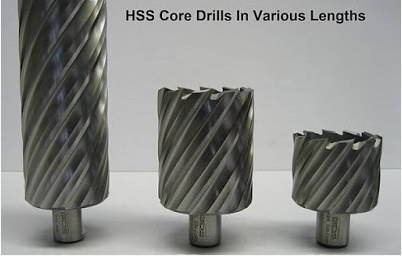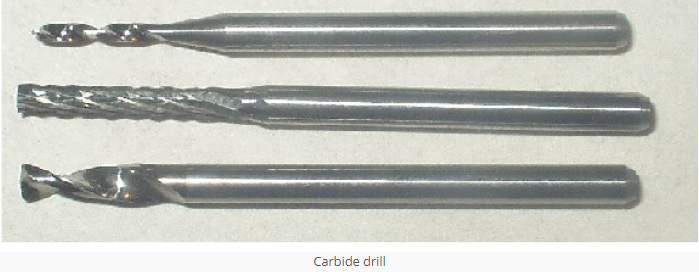5 main types of cutting tools materials properties
There are many types of cutting processes performed under different conditions. In this case and under the general requirements of cutting tools, they require some unique properties. To achieve this performance, cutting tools are made of different materials. The material selected for a particular application depends on the material to be processed, the type of processing, the quantity and the quality of production.
According to the materials used, the tools are divided into as below
1. Carbon tool steel, one of the most common cutting tools materials
Carbon Tool Steel Carbon tool steel is one of the cheap metal cutting tools used for low speed machining operations. These ordinary carbon steel cutting tools have a carbon content of 0.6-1.5% and a very small amount (less than 0.5%) of Mn, Si. Add other metals (eg Cr, V) to change the hardness and grain size. High carbon steel has wear resistance and can maintain a sharp cutting edge. Carbon tool steel has good machinability. The material quickly loses its hardness at a temperature of about 250°C. Therefore, it cannot be used in high temperature applications. It is not popular in modern machining operations.
Carbon steel tools can be used for twist drills, milling cutters, turning and forming tools, and for soft materials such as brass, aluminum and magnesium.
Temperature-450°C
Hardness-Max HRC 65
Carbon tool steel can be roughly divided into two categories: water hardened steel and oil hardened steel.
The higher the carbon content, the higher the wear resistance of the tool. In fact, when heating a quenched ordinary carbon steel tool with a tempered martensite structure, the smaller cementite particles will dissolve, and the corresponding amount of cementite will precipitate on the larger particles as long as these particles The nearby carbon has time to move into place.
The end result is that fewer and coarser carbide particles are dispersed in the ferrite matrix, so the structure is softer. In high-speed steel, this problem can be overcome by adding tungsten and molybdenum in combination with iron carbide to form complex carbides.
2. High speed steel tool (HSS), another type of cutting tools materials
This is a high carbon steel with a large number of alloying elements, such as tungsten, molybdenum, chromium, etc., which can improve hardenability, toughness and wear resistance. It has a higher metal removal rate. It loses its hardness at a moderate temperature of about 650°C. Therefore, coolant should be used to extend tool life. It can be used many times by resharpening it. The HSS has undergone some surface treatments to improve its performance.

In the first category, the most common type of high-speed steel is 18-4-1 tool steel, which is a typical representative of high-tungsten grade high-speed steel. 18-4-1 indicates that the tool steel contains 18 parts of tungsten, 4 parts of chromium and 1 part of vanadium.
During the First World War, facing the shortage of tungsten and realizing that tungsten and molybdenum behaved roughly the same, they tried to replace tungsten with molybdenum. Therefore, two other HSSs were generated in the first category. It can be noted that by weight, molybdenum is only half of tungsten to achieve the same effect.
The following lists the composition of the three first-class popular high-speed steel:

All alloys in the table above contain approximately 0.025% sulfur impurities and 0.25% manganese. Manganese will combine with sulfur and form manganese sulfide, thereby preventing embrittlement.
Sometimes, cobalt (at a ratio of 4, 8% or 12%) is added to any of these three types of high-speed steel. If added, it will lead to an increase in the thermal hardness of the steel, even exceeding 18-4-1.
The three elements tungsten, molybdenum and cobalt all contribute to a high thermal hardness. The first two are achieved by forming complex carbides. Cobalt forms an alloy by solid solution in a ferrite matrix, thereby increasing the recrystallization temperature, so the material can maintain the hardness obtained by strain hardening at a higher temperature. .
The remarkable advantages of high-speed steel tools containing cobalt, especially when cutting at high roughness, are due to their tendency to harden on the surface when they are rubbed or scratched.
Vanadium in high-speed steel will form very hard carbides (iron vanadium carbide is the hardest component in HSS), so it can improve the wear resistance of the tool at all operating temperatures. Vanadium also helps to suppress grain growth at high temperatures required for heat treatment.
For the above reasons, the increased vanadium content in tools is used to process highly abrasive materials, such as high-carbon high-chromium die steels with chromium and vanadium as the main components. These are the most ideal tools for machining high abrasives.
3. Cemented carbide Ceramics tool, a little less of cutting tools materials
Cemented carbide tools are produced by powder metallurgy technology. It consists of tungsten, tantalum, titanium carbide and cobalt as binders (when the binder is nickel or molybdenum, it is called cermet). Cemented carbide tools are very hard. They can withstand very high cutting speeds. Cemented carbide tools will not lose hardness below 1000°C. High cobalt tools are used for rough machining, while low cobalt tools are used for finishing.
Cutting speed range -60-200m/min
Temperature-1000°C
Hardness – up to HRC 90
Though it had been discovered long back that tungsten carbide is very hard material but difficulties were faced in joining fine crystals of tungsten carbides into tool bits by sintering (prolonged heating of the compressed material just below the melting point) because the required temperature was so high that the material decomposed.
Thus cemented carbide is a typical powder metallurgy product. Cemented carbides are very effective in machining cast irons and certain abrasive non-ferrous alloys, but as such are not good for cutting steel because wear craters are developed on the face of the tool.
Cemented carbide has a high hardness in a wide temperature range. Compared with steel, the thermal expansion rate is low, and the relatively high thermal conductivity makes it easy to form pressure welds at low cutting speeds. However, their tension ratio is relatively weak. Their high hardness at high temperatures allows them to be used at faster cutting speeds (low carbon steel 3-4 m/sec).
These extraordinary properties of cemented carbide require special consideration in the design of cemented carbide tools. Since cemented carbides have high stiffness, they should be well supported on handles of sufficient thickness. The tool should be proportional to keep the tensile stress small.
The expansion coefficient of cemented carbide is relatively small, so it is necessary to use a thin brazing metal layer, so that the brazing will not be broken due to the large tensile stress generated by the different shrinkage of the carbide and the brazing material when cooling. metal. Considering the back pressure welding characteristics of cemented carbide tools, their operating speed should greatly exceed the speed used by high-speed tools.
It can be mentioned that since the wear characteristics of cast iron machining are completely different from those of steel, it is necessary to use carbide grades with different properties when machining cast iron and steel. No brand can satisfy all the maximum values of the three important ideal characteristics (edge wear resistance, shrinkage resistance and impact resistance). Therefore, the choice must be compromised.

4. Cubic boron nitride Tool (CBN), the second highest hardness of cutting tools materials
It is the second highest hardness material after diamond. They are usually used in handhelds. They have high wear resistance and are used as abrasives in grinding wheels. It is not recommended to use sharp edges.
Speed 600-800m/min
Hardness-higher than HRC 95
5. Diamond tool, the hardest one of cutting tools materials
It is the hardest material known and expensive. It has high thermal conductivity and melting point. Diamond has excellent wear resistance, low coefficient of friction and low thermal expansion. It is used to process very hard materials such as carbides, nitrides, glass, etc. Diamond tools have good surface finish and dimensional accuracy. They are not recommended for processing steel.



